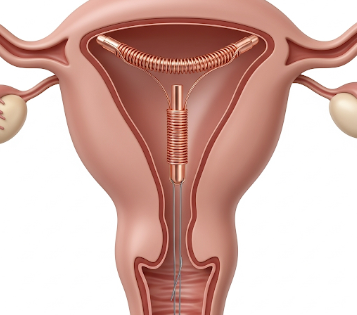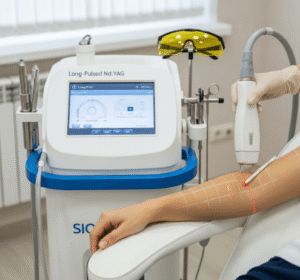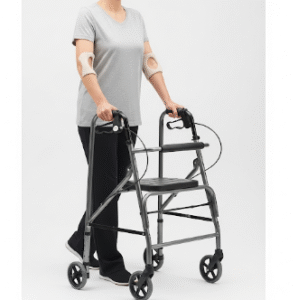What it is
An IUD (intrauterine device), commonly referred to as a copper coil, is a small, T-shaped device inserted into the uterus to prevent pregnancy. Copper IUDs are non-hormonal, using copper ions to create an environment toxic to sperm, thereby preventing fertilization.
Key points:
- Long-acting reversible contraception (LARC): Effective for 5–10 years depending on the type.
- Non-hormonal: Suitable for women who cannot use hormonal contraception.
- Highly effective: Over 99% effective in preventing pregnancy.
- Reversible: Fertility returns quickly after removal.
Why it’s done
Copper IUDs are used primarily for contraception, but also for other reasons:
- Prevent unintended pregnancy: Provides long-term, reliable contraception.
- Emergency contraception: Can be inserted within 5 days of unprotected intercourse.
- Alternative to hormonal methods: For women who prefer non-hormonal options or have contraindications.
- Menstrual regulation (indirect effect): May reduce heavy bleeding in some cases.
Note: Copper IUDs do not protect against sexually transmitted infections (STIs); barrier methods may still be recommended.
Alternatives
Other contraceptive options include:
- Hormonal IUDs: Release progestin for pregnancy prevention.
- Oral contraceptives: Daily pills for hormonal regulation.
- Implants, injections, or patches: Hormonal long-acting or short-term methods.
- Barrier methods: Male/female condoms, diaphragm, or cervical cap.
- Sterilization: Permanent contraception through tubal ligation.
Important: Copper IUDs are preferred for long-term, hormone-free contraception.
Preparation
Proper preparation ensures safe insertion and effective contraception:
- Consultation: Review medical history, allergies, previous pregnancies, infections, and menstrual history.
- Screening: Pelvic exam and possibly tests for STIs.
- Timing: Insertion is often easiest during menstruation when the cervix is slightly dilated.
- Informed consent: Discuss benefits, risks, duration, and potential side effects.
Patient instructions:
- Avoid insertion during active pelvic infection.
- Consider taking mild pain relief before the procedure.
- Plan for a brief rest period after insertion.
How it’s done
IUD insertion is a quick outpatient procedure:
- Patient positioning: Lie on an exam table with legs in stirrups.
- Cervical preparation: Clean the vagina and cervix; sometimes a local anesthetic or cervical dilator is used.
- Insertion: The IUD is loaded into an inserter and carefully placed into the uterine cavity.
- Final placement: The arms of the T-shaped device open to sit properly in the uterus.
- Trimming strings: The IUD has strings that extend slightly into the vagina for future removal or monitoring.
Duration: Usually 5–10 minutes. Mild cramping is common during and after insertion.
Recovery / Post-Procedure Considerations
Recovery is usually quick:
- Mild cramping or spotting: May last a few days to a week.
- Return to normal activities: Usually immediate; avoid heavy lifting for 24 hours if discomfort occurs.
- Follow-up check: Typically 4–6 weeks to ensure correct placement.
- Monitoring: Check IUD strings periodically to ensure device remains in place.
Benefits of correct use:
- Long-term contraception without daily attention.
- Hormone-free option for women sensitive to hormonal methods.
- Rapid return to fertility after removal.
Complications / Risks
Copper IUDs are generally safe but may involve:
- Cramping or back pain: Common during the first few days.
- Spotting or heavier periods: Can occur for several months.
- Expulsion: Rare, where the IUD partially or completely comes out.
- Perforation: Very rare; the IUD may pass through the uterine wall.
- Infection: Slight risk during insertion; usually preventable with hygiene measures.
Prevention:
- Insertion by a trained gynecologist.
- Follow post-insertion instructions and attend follow-up checks.
- Monitor for unusual pain, fever, or abnormal discharge and seek medical attention if needed.
Treatment Options in Korea
Copper IUDs are widely available in Korean hospitals, women’s health clinics, and family planning centers:
Key features:
- Offered in both public and private facilities with experienced gynecologists.
- Devices are approved by international health standards and Korean medical regulations.
- Post-insertion care includes education on IUD monitoring, contraception counseling, and follow-up visits.
- Alternative IUD options such as hormonal IUDs are also available.
- Suitable for women of all reproductive ages seeking long-term, reversible contraception.
Summary: Copper IUDs (intrauterine devices) in Korea are a safe, effective, and long-term contraceptive solution. With professional insertion, proper follow-up, and patient education, they provide hormone-free pregnancy prevention with minimal disruption to daily life.













